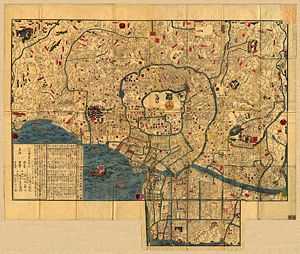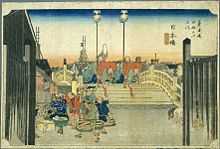Edo
| Edo 江戸 | |
|---|---|
| Former city | |
 Former location of Edo (present-day Tokyo) | |
| Coordinates: 35°41′22″N 139°41′30″E / 35.68944°N 139.69167°ECoordinates: 35°41′22″N 139°41′30″E / 35.68944°N 139.69167°E | |
| Country |
|
| Castle built | 1457 |
| De facto capital | 1603 |
| Renamed Tokyo | 1868 |
| Population (1721)[1] | |
| • Total | 1,000,000 |
Edo (江戸, literally "bay-entrance" or "estuary"), also romanized as Yedo or Yeddo, is the former name of Tokyo.[2] It was the seat of power for the Tokugawa shogunate, which ruled Japan from 1603 to 1868. During this period, it grew to become one of the largest cities in the world and home to an urban culture centered on the notion of a "floating world".[1]
History
From the establishment of the Tokugawa bakufu's headquarters at Edo, although Kyoto remained the formal capital of the country, the de facto capital and center of political power was now Edo. Edo grew from what had been a small, little-known fishing village in 1457 to a metropolis with an estimated population of 1,000,000 by 1721 (the largest city in the world at the time).[1][3]
Edo was repeatedly devastated by fires, with the Great Fire of Meireki in 1657 being the most disastrous. An estimated 100,000 people died in the fire. During the Edo period, there were about 100 fires (most begun by accident), often quickly escalating and spreading through neighbourhoods of wooden machiya which were heated with charcoal fires. Between 1600 and 1945, Edo/Tokyo was leveled every 25–50 years or so by fire, earthquakes, or war.

In 1868, when the shogunate came to an end, the city was renamed Tokyo ("eastern capital"). The emperor moved his residence to Tokyo, making the city the formal capital of Japan:
- Keiō 4: On the 17th day of the 7th month (September 3, 1868), Edo was renamed Tokyo.[4]
- Keiō 4: On the 27th day of the 8th month (October 12, 1868), Emperor Meiji was crowned in the Shishin-den in Kyoto.[5]
- Keiō 4: On the eighth day of the ninth month (October 23, 1868), the nengō was formally changed from Keiō to Meiji and a general amnesty was granted.[5]
- Meiji 2: On the 23rd day of the 10th month (1868), the emperor went to Tokyo and Edo castle became an imperial palace.[5]
Magistrate
Ishimaru Sadatsuga was the magistrate of Edo in 1661.[6]
Government and administration
During the Edo period, the shogunate appointed administrators (machi bugyō) with jurisdiction over the police and (beginning with the rule of Tokugawa Yoshimune) the fire department (machibikeshi). The machi bugyō heard criminal and civil suits, and performed other administrative functions.
Geography
The city was laid out as a castle town around Edo Castle. The area surrounding the castle (known as the Yamanote) consisted largely of daimyō (feudal lords') mansions, whose families lived in Edo as part of the sankin kōtai system; the daimyō made journeys in alternating years to Edo, and used the mansions for their entourages. It was this extensive samurai (noble warrior class) population which defined the character of Edo, particularly in contrast to the two major cities of Kyoto and Osaka (neither of which were ruled by a daimyō or had a significant samurai population). Kyoto's character was defined by the Imperial Court, the court nobles, its Buddhist temples and its history; Osaka was the country's commercial center, dominated by the chōnin (merchant class).
Areas further from the center were the domain of the chōnin (町人, literally "townsfolk"). The area known as Shitamachi (下町, lit. "lower town" or "downtown"), northeast of the castle, was a center of urban culture. The ancient Buddhist temple of Sensō-ji still stands in Asakusa, marking the center of an area of traditional Shitamachi culture. Some shops in the streets near the temple have existed continuously in the same location since the Edo period.
The Sumida River (then called the Great River, 大川), ran along the eastern edge of the city. The shogunate's official rice-storage warehouses,[7] other official buildings and some of the city's best-known restaurants were located here.
The "Japan Bridge" (日本橋, Nihon-bashi) marked the center of the city's commercial center, an area also known as Kuramae (蔵前, "in front of the storehouses"). Fishermen, craftsmen and other producers and retailers operated here. Shippers managed ships to and from Osaka (known as tarubune) and other cities, bringing goods into the city or transferring them from sea routes to river barges or land routes such as the Tōkaidō (which began there). This area remains the center of Tokyo's financial and business district.
The northeastern corner of the city, considered a dangerous direction in traditional onmyōdō (cosmology), is protected from evil by a number of temples (including Sensō-ji and Kan'ei-ji). Beyond this were the districts of the eta (outcasts), who performed "unclean" work and were separated from the main parts of the city. A long dirt path extended west from the riverbank (a short distance north of the eta districts), leading along the northern edge of the city to the Yoshiwara pleasure districts. Previously located within the city proper (near Asakusa), the districts were rebuilt in this more-remote location after the Meireki Fire of 1657.
Gallery

See Tokyo for photographs of the modern city.
See also
- Edo period
- Edo society
- Fires in Edo
- 1703 Genroku earthquake
- Edokko (native of Edo)
- History of Tokyo
- Iki (a Japanese aesthetic ideal)
- Asakusa
Notes
- ↑ 1.0 1.1 1.2 Sansom, George. A History of Japan: 1615–1867, p. 114.
- ↑ US Department of State. (1906). A digest of international law as embodied in diplomatic discussions, treaties and other international agreements (John Bassett Moore, ed.), Vol. 5, p. 759; excerpt, "The Mikado, on assuming the exercise of power at Yedo, changed the name of the city to Tokio".
- ↑ Gordon, Andrew. (2003). A Modern History of Japan from Tokugawa Times to the Present, p. 23.
- ↑ Ponsonby-Fane, Richard. (1956). Kyoto: the Old Capital, 794–1869, p. 327.
- ↑ 5.0 5.1 5.2 Ponsonby-Fane, p. 328.
- ↑ Encyclopædia Britannica (1911): "Japan: Commerce in Tokugawa Times," p. 201.
- ↑ Taxes, and samurai stipends, were paid not in coin, but in rice. See koku.
References
- Forbes, Andrew; Henley, David (2014). 100 Famous Views of Edo. Chiang Mai: Cognoscenti Books. ASIN: B00HR3RHUY
- Gordon, Andrew. (2003). A Modern History of Japan from Tokugawa Times to the Present. Oxford: Oxford University Press. ISBN 0-19-511060-9/ISBN 978-0-19-511060-9 (cloth); ISBN 0-19-511061-7/ISBN 978-0-19-511061-6.
- Ponsonby-Fane, Richard. (1956). Kyoto: the Old Capital, 794–1869. Kyoto: Ponsonby Memorial Society.
- Sansom, George. (1963). A History of Japan: 1615–1867. Stanford: Stanford University Press. ISBN 0-8047-0527-5/ISBN 978-0-8047-0527-1.
- Akira Naito (Author), Kazuo Hozumi. Edo, the City that Became Tokyo: An Illustrated History. Kodansha International, Tokyo (2003). ISBN 4-7700-2757-5
- Alternate spelling from 1911 Encyclopædia Britannica article.
External links
| Wikimedia Commons has media related to Edo. |
- A Trip to Old Edo
- (Japanese) Fukagawa Edo Museum
Historic
- Map of Bushū Toshima District, Edo from 1682
